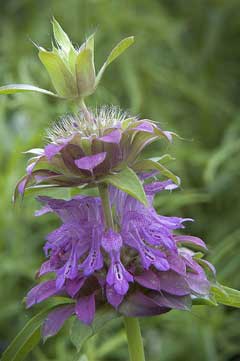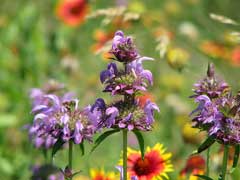 |
|
www.flickr.com/photos/dawilson |
 |
| www.flickr.com/photos/matthigh |
Translate this page:
Summary
Bloom Color: Pink. Main Bloom Time: Early summer, Late spring, Mid summer. Form: Upright or erect.
Physical Characteristics

 Monarda citriodora is a ANNUAL/PERENNIAL growing to 0.6 m (2ft) at a fast rate.
Monarda citriodora is a ANNUAL/PERENNIAL growing to 0.6 m (2ft) at a fast rate.
See above for USDA hardiness. It is hardy to UK zone 6. It is in flower from July to August. The species is hermaphrodite (has both male and female organs) and is pollinated by Bees. The plant is self-fertile.
It is noted for attracting wildlife.
Suitable for: light (sandy), medium (loamy) and heavy (clay) soils. Suitable pH: mildly acid, neutral and basic (mildly alkaline) soils. It can grow in semi-shade (light woodland) or no shade. It prefers moist soil.
UK Hardiness Map
US Hardiness Map
Synonyms
Plant Habitats
Cultivated Beds;
Edible Uses
Edible Parts: Leaves
Edible Uses: Condiment Tea
Leaves - raw or cooked. They are used as a flavouring in salads and cooked foods[46, 105, 161, K] and also as a tea[183]. They have a pleasant lemon flavour[238].
References More on Edible Uses
Medicinal Uses
Plants For A Future can not take any responsibility for any adverse effects from the use of plants. Always seek advice from a professional before using a plant medicinally.
None known
References More on Medicinal Uses
The Bookshop: Edible Plant Books
Our Latest books on Perennial Plants For Food Forests and Permaculture Gardens in paperback or digital formats.

Edible Tropical Plants
Food Forest Plants for Hotter Conditions: 250+ Plants For Tropical Food Forests & Permaculture Gardens.
More

Edible Temperate Plants
Plants for Your Food Forest: 500 Plants for Temperate Food Forests & Permaculture Gardens.
More

More Books
PFAF have eight books available in paperback and digital formats. Browse the shop for more information.
Shop Now
Other Uses
Essential Repellent
An essential oil in the leaves contains a phenol and a citral[4]. No more information is given, though the oil is likely to have medicinal activity and perhaps be suitable for perfumery etc[K]. The essential oil citronellal, used as an insect repellent and in perfumery, is obtained from this plant[274].
Special Uses
Attracts Wildlife Scented Plants
References More on Other Uses
Cultivation details
Landscape Uses:Border, Massing, Specimen. An easily grown plant, succeeding in ordinary garden soil so long as it is not too dry[1]. Requires a moist soil and a sunny position[1, 200]. Likes some shade. Prefers a sandy rather acidic soil[200]. This species is closely related to M. pectinata[235]. Said to be a perennial in some books and an annual in others, it has acted as an annual with us so far[K]. A good bee plant[200]. Subject to mildew in dry summers[200]. Special Features:
Attracts birds, North American native, Edible, Fragrant foliage, Attracts butterflies.
References Carbon Farming Information and Carbon Sequestration Information
Temperature Converter
Type a value in the Celsius field to convert the value to Fahrenheit:
Fahrenheit:
The PFAF Bookshop
Plants For A Future have a number of books available in paperback and digital form. Book titles include Edible Plants, Edible Perennials, Edible Trees,Edible Shrubs, Woodland Gardening, and Temperate Food Forest Plants. Our new book is Food Forest Plants For Hotter Conditions (Tropical and Sub-Tropical).
Shop Now
Plant Propagation
Seed - sow mid to late spring in a cold frame. Germination usually takes place within 10 - 40 days at 20°c. When large enough to handle, prick the seedlings out into individual pots and plant them out into their permanent positions in early summer. The seed can also be sown in situ in late summer in areas where the winters are not too severe and will produce larger plants. Cuttings of soft basal shoots in spring. Harvest the shoots with plenty of underground stem when they are about 8 - 10cm above the ground. Pot them up into individual pots and keep them in light shade in a cold frame or greenhouse until they are rooting well. Plant them out in the summer. Division in spring or autumn.
Other Names
If available other names are mentioned here
Native Range
NORTHERN AMERICA: United States (Kansas, Missouri (west), Oklahoma, Arkansas, New Mexico, Texas, Arizona (southeast)), Mexico (Chihuahua, Coahuila de Zaragoza, Durango, Nuevo León, Sinaloa, Sonora (east), Tamaulipas, Michoacán de Ocampo)
Weed Potential
Right plant wrong place. We are currently updating this section.
Please note that a plant may be invasive in one area but may not in your area so it's worth checking.
Conservation Status
IUCN Red List of Threatened Plants Status :

| Related Plants
|
| Latin Name | Common Name | Habit | Height | Hardiness | Growth | Soil | Shade | Moisture | Edible | Medicinal | Other |
| Monarda clinopodia | White Basil-Balm, White bergamot | Perennial | 1.3 |
4-8
| | LMH | SN | M | 1 | 0 | |
| Monarda didyma | Bergamot, Scarlet beebalm, Horsemint, Oswego Tea, Bee Balm | Perennial | 0.9 |
4-10
| M | LMH | SN | M | 3 | 2 | 3 |
| Monarda fistulosa | Wild Bergamot, Mintleaf bergamot, Wild Bee-Balm, Lupine | Perennial | 1.5 |
4-10
| M | LMH | N | DM | 3 | 2 | 2 |
| Monarda menthifolia | Mint-Leaved Bergamot, Mintleaf bergamot | Perennial | 0.8 |
3-7
| | LMH | SN | M | 1 | 2 | |
| Monarda pectinata | Plains Lemon Monarda, Pony beebalm | Annual/Perennial | 1.0 |
0-0
| | LMH | N | DM | 1 | 2 | 0 |
| Monarda punctata | Horse Mint, Spotted beebalm | Annual/Perennial | 0.8 |
5-9
| | LMH | SN | DM | 1 | 3 | 1 |
|
Growth: S = slow M = medium F = fast. Soil: L = light (sandy) M = medium H = heavy (clay). pH: A = acid N = neutral B = basic (alkaline). Shade: F = full shade S = semi-shade N = no shade. Moisture: D = dry M = Moist We = wet Wa = water.
Now available:
Food Forest Plants for Mediterranean Conditions
350+ Perennial Plants For Mediterranean and Drier Food Forests and Permaculture Gardens.
[Paperback and eBook]
This is the third in Plants For A Future's series of plant guides for food forests tailored to
specific climate zones. Following volumes on temperate and tropical ecosystems, this book focuses
on species suited to Mediterranean conditions—regions with hot, dry summers and cool, wet winters,
often facing the added challenge of climate change.
Read More
Expert comment
Author
Cerv. ex Lag.
Botanical References
43200
Links / References
For a list of references used on this page please go here
Readers comment
© 2010, Plants For A Future. Plants For A Future is a charitable company limited by guarantee, registered in England and Wales. Charity No. 1057719, Company No. 3204567.